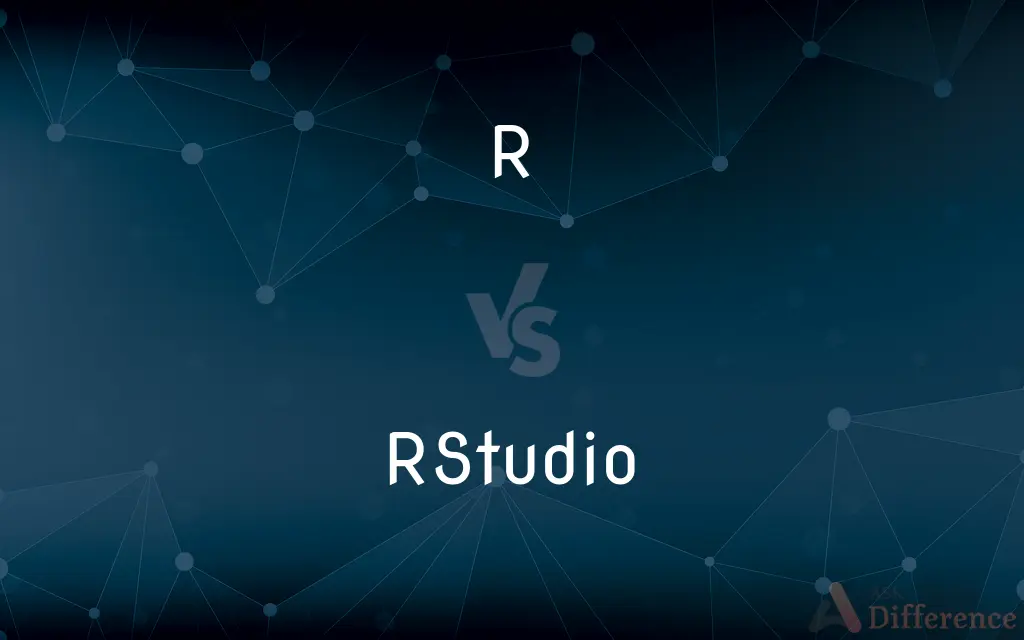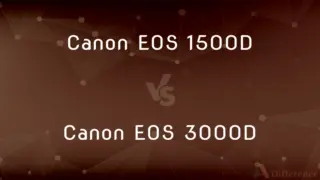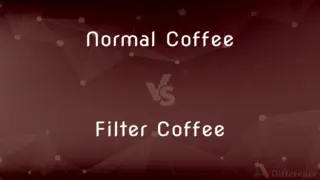R vs. RStudio — What's the Difference?
By Tayyaba Rehman — Published on January 24, 2024
R is a programming language mainly used for statistical computing and graphics. RStudio is an integrated development environment (IDE) for R, providing a user-friendly interface and additional tools for coding in R.

Difference Between R and RStudio
Table of Contents
ADVERTISEMENT
Key Differences
R is a programming language and software environment developed for statistical analysis, graphical representation, and reporting. On the other hand, RStudio acts as a powerful and comprehensive IDE that enhances the use of R by providing an organized workspace with various tools for script writing, data visualization, and package management. Both are widely used in data analysis, yet they serve different functions in the workflow.
R offers a wide array of statistical and graphical techniques, including linear and nonlinear modeling, classical statistical tests, time-series analysis, and clustering. RStudio, in contrast, facilitates these analyses by offering features like syntax highlighting, code completion, and the ability to view graphs and data tables in the same window. While R is the core language, RStudio provides a more efficient and user-friendly way to interact with R.
R is open-source and can be run in various environments like Windows, Mac, and Linux. Conversely, RStudio is also available on these platforms but adds an additional layer of usability by incorporating an integrated R console, source code editor, and tools for plotting, history, debugging, and workspace management, which are not inherent features of R itself.
R is known for its extensive community and wide range of packages which can be used for diverse types of data analysis. RStudio complements this by providing a seamless environment for package installation and management, making it easier for users to access and utilize the vast array of tools available in R.
R, being a programming language, requires coding knowledge to perform tasks. In contrast, RStudio offers several shortcuts and aids like point-and-click interface options for some tasks, reducing the coding burden on the user. While R is the backbone of statistical computation, RStudio acts as the facilitator for a smoother and more intuitive coding experience.
ADVERTISEMENT
Comparison Chart
Nature
Programming language
Integrated Development Environment (IDE)
Usage
Statistical computing, data analysis
Enhancing the use of R with additional tools
User Interface
Command-line interface
Graphical user interface with additional features
Functionality
Core statistical analysis and graphing capabilities
Code editing, debugging, version control integration
Accessibility
Requires coding knowledge
Provides a more user-friendly interface for R
Compare with Definitions
R
Open-Source: R is open-source software.
Being open-source, R has a vast community contributing to its development.
RStudio
Facilitator: RStudio facilitates the use of R.
RStudio enhances the coding experience with its advanced features.
R
Community: R has a vibrant community.
The R community regularly contributes new packages and functions.
RStudio
Supportive: RStudio supports advanced coding in R.
RStudio’s debugging tools are essential for complex R projects.
R
Graphics: R excels in graphical capabilities.
We used R to create detailed plots of our data.
RStudio
Tool Integration: RStudio integrates various development tools.
RStudio’s integrated tools streamline the data analysis process.
R
Language: R is a language for statistical computing.
Using R, we performed a complex statistical analysis.
RStudio
IDE: RStudio is an integrated development environment for R.
RStudio makes writing R scripts more efficient.
R
Environment: R serves as an environment for statistical analysis.
In the R environment, you can easily manipulate data sets.
RStudio
User-Friendly: RStudio offers a user-friendly interface.
With RStudio, beginners can more easily navigate through R programming.
Common Curiosities
How do R and RStudio differ?
R is the language itself, while RStudio is a tool that makes using R easier and more efficient.
How does RStudio improve the use of R?
RStudio provides an organized workspace, debugging tools, and easy package management.
What is RStudio?
RStudio is an integrated development environment (IDE) specifically for R.
Can RStudio work with languages other than R?
RStudio is primarily designed for R, though it can support other languages like Python to some extent.
What kind of tasks is R used for?
R is used for statistical analysis, data visualization, and data science projects.
Is R suitable for beginners in programming?
Yes, R is accessible to beginners, especially with the help of RStudio.
Are R and RStudio free?
Yes, both R and RStudio are free and open-source.
Can RStudio run without installing R?
No, RStudio requires R to be installed as it is an IDE for R.
What is R?
R is a programming language used for statistical computing and graphics.
Is RStudio necessary to use R?
No, R can be used without RStudio, but RStudio provides helpful tools and a user-friendly interface.
Is there a community for R and RStudio users?
Yes, there is a large and active community for both R and RStudio users, offering support and resources.
Does RStudio help with learning R?
Yes, RStudio's user-friendly interface and additional features can make learning R easier.
What platforms support R and RStudio?
Both are available for Windows, macOS, and Linux.
Is R only for statisticians?
While popular among statisticians, R is also widely used in various fields like data science and biotechnology.
Can R handle large datasets?
Yes, R can process large datasets, especially with the right packages and tools.
Share Your Discovery

Previous Comparison
Canon EOS 1500D vs. Canon EOS 3000D
Next Comparison
Normal Coffee vs. Filter CoffeeAuthor Spotlight
Written by
Tayyaba RehmanTayyaba Rehman is a distinguished writer, currently serving as a primary contributor to askdifference.com. As a researcher in semantics and etymology, Tayyaba's passion for the complexity of languages and their distinctions has found a perfect home on the platform. Tayyaba delves into the intricacies of language, distinguishing between commonly confused words and phrases, thereby providing clarity for readers worldwide.
















































